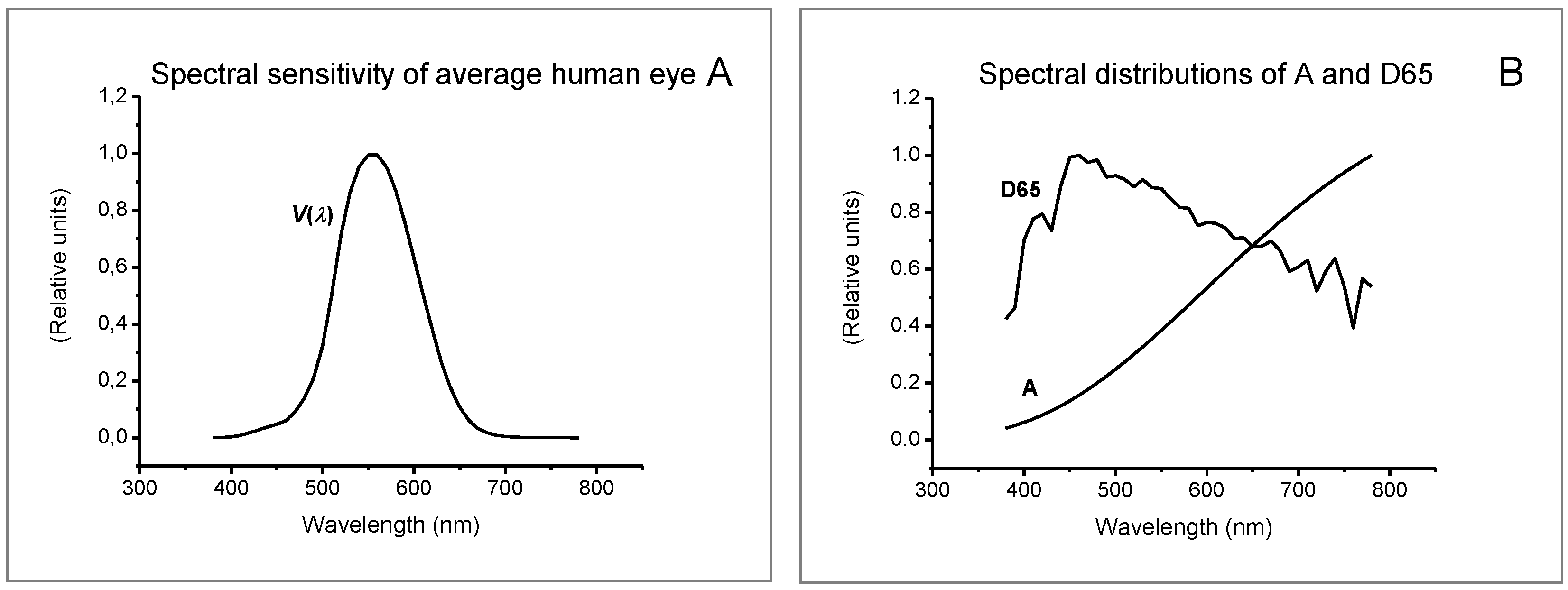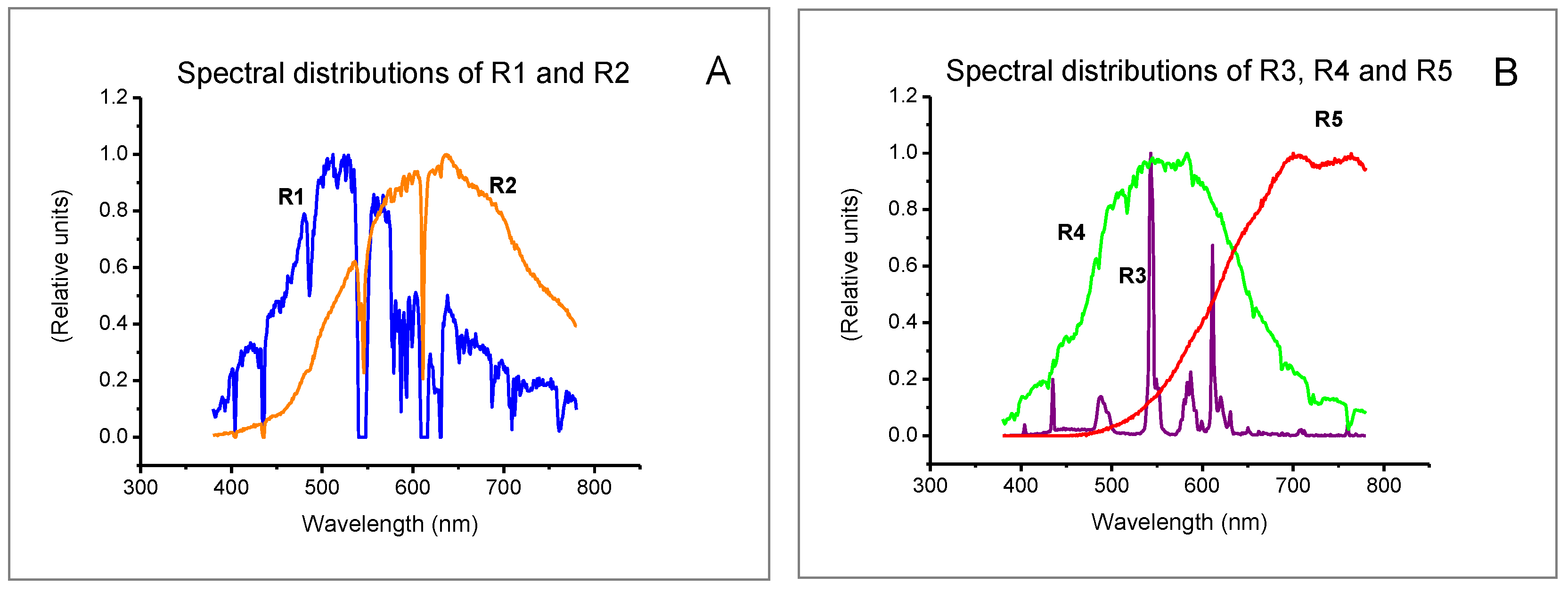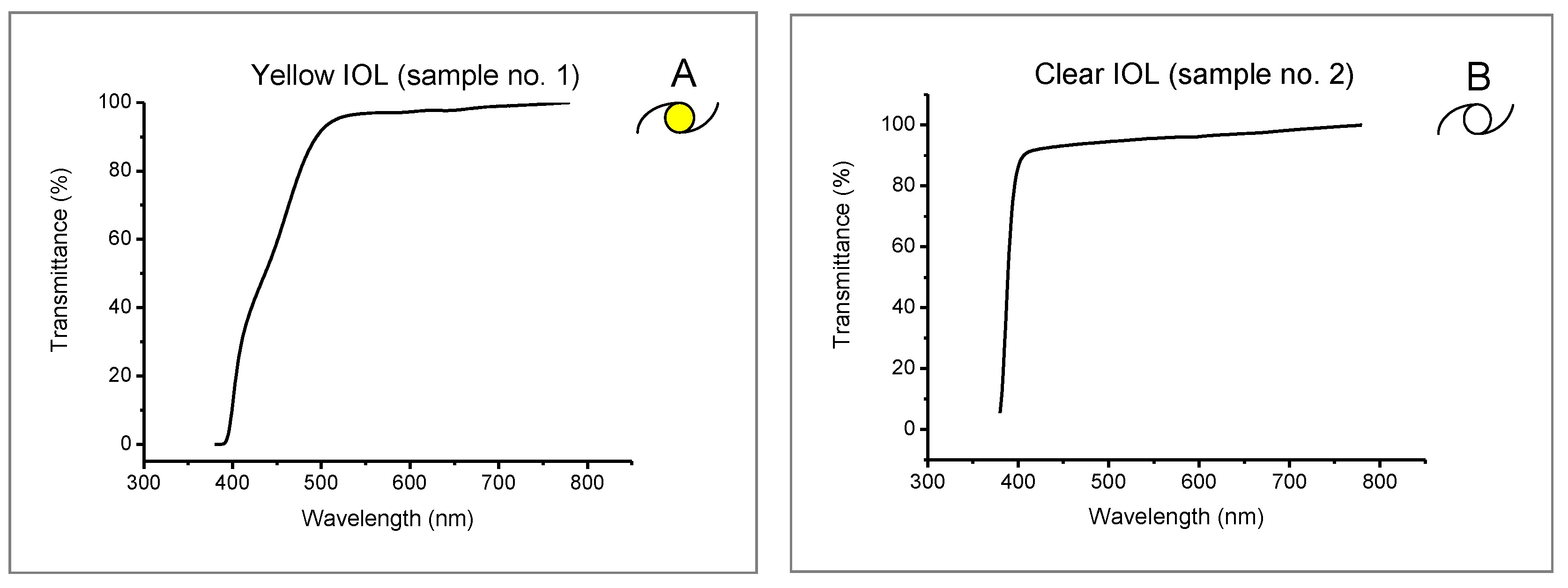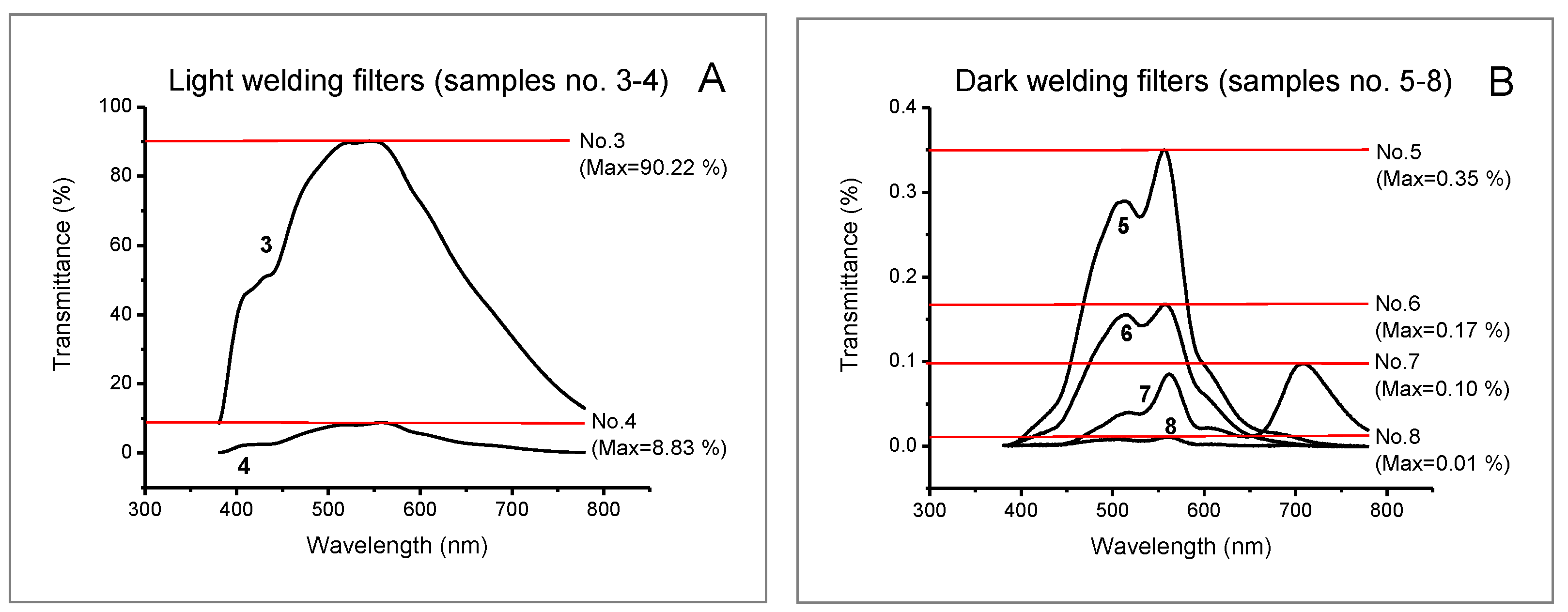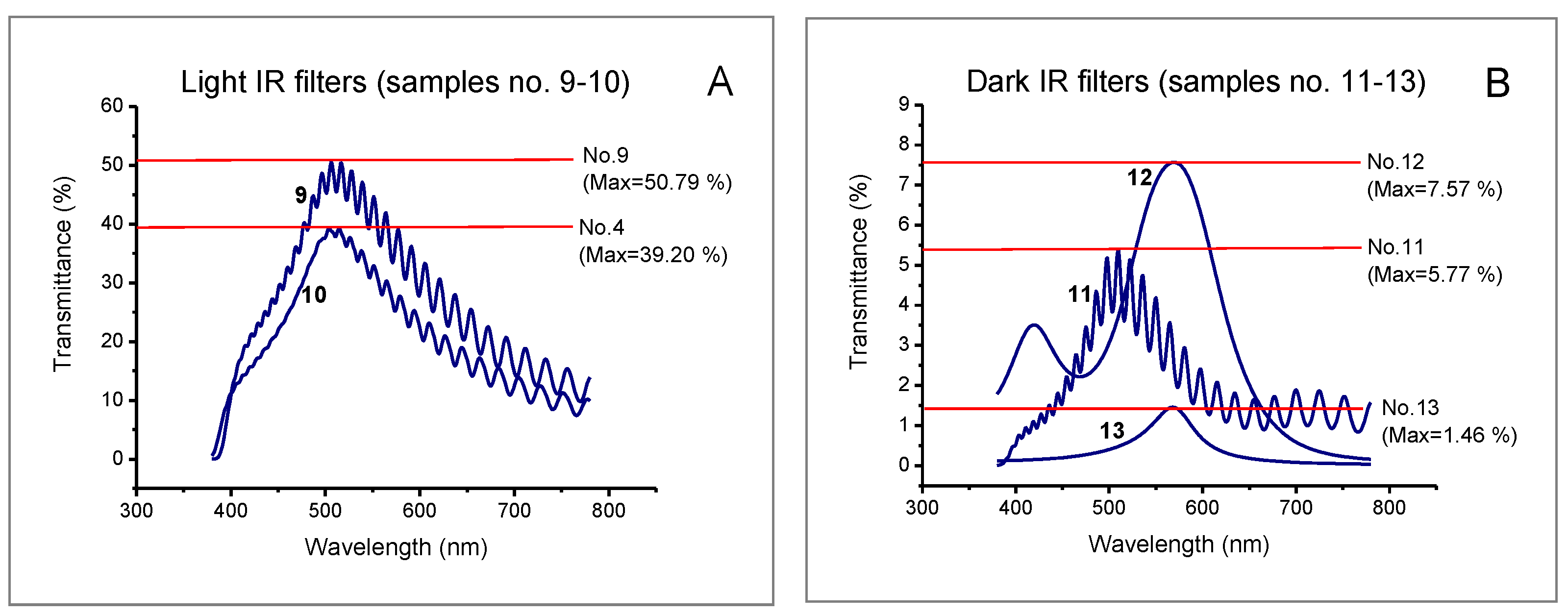1. Introduction
The objective of the study was to examine changes in vision quality in situations where individuals with intraocular lens implants are obligated to use protective filters. Given that eye protection devices are routinely used in certain workplaces, it was necessary to investigate the effects of IOLs on the protective performance of those devices (filters). This paper presents a method for determining the luminous transmittance of systems consisting of protective optical filters and intraocular lenses (IOLs), using standard and real illuminants with different spectral power distributions. Spectral characteristics were measured for two types of IOLs (clear and yellow—with yellow chromophore) and for two types of protective optical filters (welding and IR filters—protecting against infrared radiation), which significantly differed in optical density. A light transmittance reduction factor for the filter-IOL systems was defined. The methodology presented in this paper and the obtained results can be used to determine the effects of IOLs on the classification of protective optical filters for people with implanted IOLs. The paper described consecutive methodological steps in the evaluation of the protective performance of the filter-IOL system.
There is some clinical and investigative evidence that blue light filtering IOLs (yellow IOLs) may reduce the risk of age-related macular degeneration [
1]. The literature is not conclusive in terms of the influence of IOLs on contrast sensitivity and color vision [
2,
3]. Small differences in visual function were noted by Wirtitsch et al. in the case of tinted lenses [
4]. In turn, Eberhard et al. [
3] did not arrive at a clear answer as to the effects of two types of lenses on preserving visual function. However, according to several authors, contrast and color sensitivity decrease under mesopic conditions [
5,
6,
7,
8]. Mainster reported that yellow-tinted IOLs could have a negative influence on scotopic and mesopic contrast sensitivity due to the Purkinje shift, since blue light is much more important for scotopic than for photopic vision [
9,
10]. In a work by Li et al., blue-light-filtering IOLs reduced scotopic sensitivity by 14–21%, depending on dioptric power [
11]. Ao et al. [
6] found that there was a statistically significant difference in partial error scores in the green to blue-green color band under mesopic, but not photopic, conditions. The literature is clear on mesopic and scotopic contrast sensitivity in people with IOLs. This concerns many professionals, e.g., steelworkers and welders, who need to use protective filters in the workplace. To date, no studies have examined the influence of clear or yellow IOLs on the vision of users of optical filters. Visual function (including color recognition, identification of objects in the surroundings, control of technological processes, etc.) during use of optical filters depends on the spectral characteristics of the filters in the visible range. So far, the effectiveness of protective optical filters has been determined with regard to the protective filter-eye system. If the natural lens is replaced by an IOL, the level of harmful optical radiation blocked can change, and certain eye functions that are important while performing tasks in the work environment may be modified since visual stimuli may be received differently by persons after cataract surgery or refractive correction with clear or yellow IOL implantation, especially under low light conditions (characteristic of certain work stations). The objective of the work was to determine whether people with IOLs will need different levels of protection while using optical filters against harmful optical radiation as well as whether IOLs can change the category of protective filters required by them.
2. Materials and Methods
The study involved two acrylic and hydrophobic intraocular lenses: Alcon SN6AT3 and Artis PL E. The Alcon lens has a yellow chromophore (blue light filter) absorbing wavelengths of up to approx. 475 nm to prevent the harmful effects of radiation in this range on the retina. The IOLs were used in conjunction with welding and infrared (IR) filters characterized by different degrees of optical density to visible radiation; these included welding filters [
12] with shade numbers: 2 (sample 3), 5 (sample 4), 8 (sample 5), 9 (sample 6), 10 (sample 7), and 12 (sample 8) as well as IR filters [
13] with shade numbers: 4–3 (sample 9), 4–4 (sample 10), 4–5 (samples 11 and 12), and 4–7 (sample 13).
The spectral characteristics of the tested samples (intraocular lenses, welding filters, and IR filters) were determined using a CARY 5000 Varian spectrophotometer (Australia). In the sample compartment, each filter and IOL was placed so that the measuring beam would fall perpendicularly to its surface and then directly reach the photodetector.
A mathematical method is hereby proposed for determining the spectral characteristics of filter-IOL systems to eliminate the decrease in transmission levels associated with spectrophotometric measurement in the sample compartment. In this method, the spectral characteristics of the filter (
τ(
λ)
F) and the IOL (
τ(
λ)
IOL) are calculated separately and are then combined to compute the filter-IOL transmission coefficient (
τ(
λ)
F+IOL). The spectral transmission coefficients of the IOLs and filters comprising filter-IOL systems are expressed by Formulas (1) and (2).
where:
Q0(λ)—light beam incident on the filter,
Q1(λ)—light beam passing through the filter,
Q2(λ)—light beam passing through the filter-IOL system.
A formula for the luminous transmittance of filter-IOL systems is obtained from Formulas (1) and (2), and is expressed as follows.
As can be seen from Formula (3), the luminous transmittance of the filter-IOL system (
τ(
λ)
F+IOL) is a product of the spectral transmittance of the filter (τ(λ)
F) and that of the IOL (τ(λ)
IOL). Spectral characteristics were used to determine luminous transmittance in accordance with Formula (4) below [
14].
where:
τ (λ)—spectral transmittance,
S(λ)—spectral power distribution of the illuminant,
V(λ)—spectral sensitivity function of the average human eye to daylight.
Luminous transmittance was determined from Formula (4) for the spectral sensitivity function of the average human eye to daylight and the spectral power distribution of standard illuminants (A, D65) as well as illuminants corresponding to the following real conditions: R1—natural light from a cloudy sky, R2—room lit by halogen lamps (Osram, 59 W/12 V), R3—room lit by fluorescent lamps (Philips TLD 58/840), R4—room lit by LED lamps (SMD 3630, 5.9 W/11 V/350 lm, 3000 K), and R5—room lit by radiation emitted from a laboratory furnace operating at a temperature of 1000°C. The real illuminants were supposed to mimic actual working conditions. Spectral power distributions were determined using an HR 2000+ spectroradiometer (Ocean Optics, USA) equipped with an optical fiber and an optical radiation diffuser.
Figure 1 presents the spectral distributions of the standard weight functions used to determine luminous transmittance, i.e., the spectral sensitivity function of the average human eye to daylight and the spectral power distribution for illuminant D65.
Figure 2 presents the spectral distributions of illuminants determined under real conditions (from R1 to R5).
Seven values of luminous transmittance were determined for each of the samples tested: intraocular lenses, welding filters, and IR filters (τv/day/i with i representing the illuminant included in the calculation, that is, D65, A, R1, R2, R3, R4, or R5). Luminous transmittance was also determined for filter-IOL systems.
Subsequently, relative changes in luminous transmittance for welding filters and IR filters, as well as filter-IOL systems were determined. Relative changes in luminous transmittance were determined from Formula (5).
where:
i—symbol of the illuminant included in the calculation (i = D65, A, R1, R2, R3, R4, R5),
τv/day/i/F—luminous transmittance of the filter for illuminant i,
τv/day/i/F+IOL—luminous transmittance of the filter–IOL system for illuminant i.
If a relative change in luminous transmittance is expressed as a non-percent value, Formula (5) can be used to define an equation for comparing the luminous transmittance of a filter and that of the filter-IOL system:
where:
i—symbol of illuminant included in the calculation (i = D65, A, R1, R2, R3, R4, R5),
τv/day/i/F—luminous transmittance of the filter for illuminant i,
τv/day/i/F+IOL—luminous transmittance of the filter-IOL system for illuminant i.
The factor (1—Δ
τv/i) in Formula (6) determines the ratio of the luminous transmittance of the filter-IOL system to that of the filter itself. This factor was defined as the transmittance reduction factor of the filter-IOL system:
where:
∆τv/i—relative change in luminous transmittance determined for the filter and the filter-IOL system.
4. Discussion
Plots of the spectral characteristics of luminous transmittance obtained for the tested IOLs (see
Figure 1) indicate a significant decrease of transmittance for those with yellow chromophore within the range up to approx. 475 nm, as compared to IOLs without chromophore. However, this does not mean that luminous transmittance determined for the entire visible light range from 380 to 780 nm was lower for yellow IOLs vs. clear IOLs. As can be seen from
Table 1, irrespective of the illuminant distribution, those coefficients differed only slightly except for illuminant R1 (natural light from a cloudy sky), where the difference (Δ
τv/IOL =
τv/IOL/clear −
τv/IOL/yellow) was 9.29%. That means that under low-intensity daylight, yellow IOL transmitted much less light. In all the other cases (illuminants D65, A, and R2–R5), the luminous transmittance for IOLs with chromophore was slightly higher than for clear IOLs, with the differences ranging from 0.15% (for R3) to 2.09% (for R5). Relative changes in luminous transmittance for clear and yellow IOLs ranged from 2.13% (for R5) to 10.78% (for R1).
The luminous transmittance coefficients determined for two types of IOLs under standard (D65; A) and real (R1–R4) illuminants indicate that the amount of light reaching the retina (vision quality) slightly declined for the users of IOLs with yellow chromophore working under low-intensity daylight (R1—cloudy day). According to the literature, mesopic and scotopic conditions may affect vision in individuals with IOLs. Therefore, the study involved protective filters used in the welding and foundry industry, which may lead to mesopic or scotopic vision.
Plots of the spectral characteristics of luminous transmittance obtained for the tested welding filters (see
Figure 2) show that irrespective of filter shade number, maximum transmission occurred from approx. 520 to 550 nm. The luminous transmittance for welding filters (see
Table 2) did not differ significantly for illuminants D65, A, and R1–R4. In the case of the distribution of illuminant R5 (room lit by radiation emitted from a laboratory furnace), the luminous transmittance coefficients for all tested welding filters were lower than for the other illuminants. In the case of the darkest filter tested (sample 8), the difference in luminous transmittance coefficients determined for illuminants D65 (
τv/day/D65 = 0.0060%) and R5 (
τv/day/R5 = 0.0057%) amounted to as little as 0.0003%. However, the difference was significant as the filter was already very dark. The relative change in the luminous transmittance coefficient obtained for that filter using the standard illuminant D65 was as much as 31.7% as compared to R5. In turn, as far as the least dark welding filter is concerned (sample 3), the difference in luminous transmittance between D65 and R5 was 7.93%. The relative change in the luminous transmittance coefficient for that filter, measured for the standard illuminant D65 vs. R5, was 9.66%. In the case of the other tested welding filters (samples 4–7), those changes were 15.2%, 31.0%, 28.3%, and 15.2%. Importantly, they were not affected by the IOL type (yellow or clear). Nevertheless, the luminous transmittance of IOLs with chromophore tended to be slightly higher, as already mentioned.
Relative changes in the luminous transmittance for welding filters and welding filter-IOL systems were calculated on the basis of data from
Table 2 (see Equation (5)).
Table 4 and
Table 5 give the results of those calculations for IOLs with and without yellow chromophore, respectively. As can be seen from those tables, relative changes in the luminous transmittance did not depend on how dark the filter was. Rather small differences were found for different illuminant distributions, with lower values obtained for illuminant R5.
As can be seen from
Table 6 and
Table 7, the calculated transmittance reduction factors were similar (0.95 to 0.99 relative units) for all welding filter-IOL systems irrespective of the presence or absence of yellow chromophore. This indicates that the quality of vision through the analyzed welding filters will not change for the analyzed cases.
Plots of the spectral characteristics of luminous transmittance obtained for the tested IR filters (see
Figure 3) show that irrespective of filter shade number, maximum transmission was found between approx. 500 and 550 nm. The luminous transmittance coefficients of IR filters (see
Table 3) did not differ significantly for the following illuminant distributions: D65, A, and R1–R4. Similarly, as in the above-mentioned welding filters, in the case of illuminant R5 (room lit by radiation emitted from a laboratory furnace) the luminous transmittance coefficients (
τv/day/R5) for all the studied IR filters were lower as compared to other illuminants.
Relative changes in the luminous transmittance for IR filters and IR filter-IOL systems were calculated on the basis of data from
Table 3 (see Equation (5)). Relative changes in the luminous transmittance for the tested IR filters (samples 9 to 13), determined for illuminant D65 vs. R5 amounted to 11.6%, 16.8%, 19.2%, 29.9%, and 7.14%.
The results are presented in
Table 8 and
Table 9 for IOLs with and without yellow chromophore, respectively. As can be seen from the tables, relative changes in the luminous transmittance were unaffected by the shade number of the filter. The differences between the various illuminant distributions were generally small, but it should be noted that they were slightly greater for IR filter-IOL systems without chromophore.
As can be seen from
Table 10 and
Table 11, the calculated transmittance reduction factors ranged from 0.88 to 0.99 relative units for all welding filter-IOL systems irrespective of the presence or absence of yellow chromophore in the IOL or filter characteristics. This indicates that the quality of vision through the analyzed filters and IOLs will not be significantly affected under the studied light conditions.
It was found that the type of illuminant had a significant effect on welding filters irrespective of IOL type. Transmittance coefficients calculated on the basis of the spectral characteristics of the standard illuminant D65 were compared with real illuminants imitating, e.g., poor light conditions in the workplace (illuminant R5). Significant changes for those coefficients (at 32%) were recorded for sample 8. In practice, this may affect the worker’s vision, compromising work comfort and quality. Similar results were found for IR filters used in the foundry industry. Relative changes in transmittance calculated for illuminant R5 as compared to the standard illuminant D65 were almost 30% (sample 12). In the case of welding filter-IOL systems, changes in luminous transmittance did not depend on the filter shade number. It was also found that in conjunction with welding filters, IOL type affects relative luminous transmittance. The systems containing IOLs without chromophore revealed higher levels of that coefficient.
